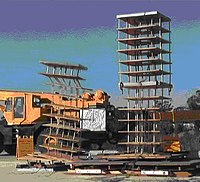
Photo from wikipedia
Abstract This study presents a large-scale shaking table investigation aimed at the development of a dual, low-cost hybrid design approach for the reduction of seismic damage in developing countries. The… Click to show full abstract
Abstract This study presents a large-scale shaking table investigation aimed at the development of a dual, low-cost hybrid design approach for the reduction of seismic damage in developing countries. The introduction of a novel seismic isolation strategy, defined as ‘PVC sand-wich’ seismic isolation lies in the core of the proposed hybrid approach. The latter relates to conventional, ‘good practice’ design (including steel wire mesh wall retrofit and connecting ties) that permits strength-based resistance to lateral loads for intensity up to the design earthquake combined with a sliding ‘fuse’ mechanism that is triggered once the above threshold is exceeded. A three times scaled-down seismically isolated masonry model of a prototype structure located in Nepal is designed, constructed according to the proposed design approach and tested to earthquake ground motion excitations on a 3 m × 3 m shaking table. The efficiency of the proposed design approach is assessed through the experimental investigation of the seismically isolated structure, while the seismic response of the corresponding unretrofitted masonry structure is simulated numerically. The results demonstrate that the PVC sand-wich isolation mechanism can be a promising alternative to more expensive damage mitigating solutions.
Journal Title: Soil Dynamics and Earthquake Engineering
Year Published: 2021
Link to full text (if available)
Share on Social Media: Sign Up to like & get
recommendations!